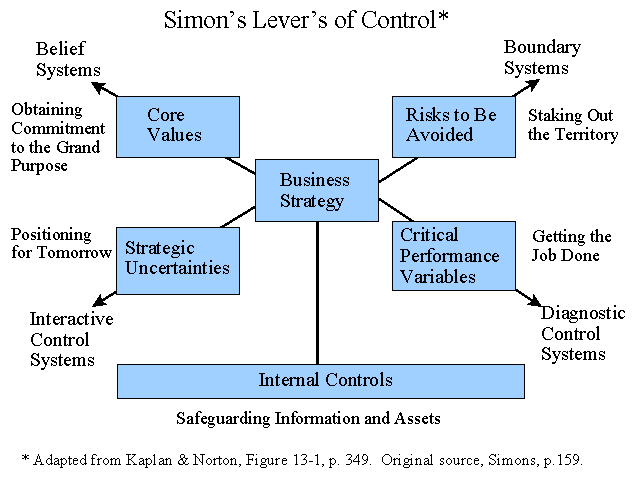
Summary by James R. Martin, Ph.D., CMA
Professor Emeritus, University of South Florida
Balanced Scorecard Main Page | Behavioral
Issues Main Page | Control/Controllership Main Page
In Chapter 10 of The Strategy-Focused Organization 1, Kaplan and Norton discuss Simons2 five levers of control. The purpose of this note is to summarize their discussion in an attempt to clear up some of the confusion about how the balanced scorecard should be used, or at least provide a basis for discussing the confusion.
The five control levers include:
1. Belief systems,
2. Boundary systems,
3. Internal control systems,
4. Diagnostic systems, and
5. Interactive systems.
Belief systems relate to the fundamental values of the organization. Examples in this category include mission statements and vision statements.
Boundary systems describe constraints in terms of employee behavior, i.e., forbidden actions.
Internal control systems are related to protecting assets, while
Diagnostic systems theoretically provide information indicating when a system is in control or out of control.
Interactive systems focus on communicating and implementing the organization's strategy. The purpose of an interactive system is to promote debate related to the assumptions underlying the organization's strategy and ultimately to promote learning and growth.
The following graphic illustration was adapted from Figure 13-1 (p. 349) in Kaplan & Norton's book. The original source is from Simon's book (p. 159).

The confusion is related to how and where the balanced scorecard fits into the levers of control. According to Kaplan & Norton, successful balance scorecard adopters use the scorecard as an interactive system (p. 350). Some balanced scorecard implementations have failed because companies used the scorecard as only a diagnostic system.
Simons' term "interactive system" seems to be essentially the same as Kaplan & Norton's term "strategic system". The message is, to obtain the potential benefits of the balanced scorecard, an organization has to use it as a strategic system.
______________________________________________
References and related summaries:
Kaplan, R. S. and D. P. Norton. 1992. The balanced scorecard - Measures that drive performance. Harvard Business Review (January/February): 71-79. (Summary).
Kaplan, R. S. and D. P. Norton. 1993. Putting the balanced scorecard to work. Harvard Business Review (September-October): 134-147. (Summary).
Kaplan, R. S. and D. P. Norton. 1996. The Balanced Scorecard: Translating Strategy into Action Boston: Harvard Business School Press. (Summary).
Kaplan, R. S. and D. P. Norton. 1996. Using the balanced scorecard as a strategic management system. Harvard Business Review (January-February): 75-85. (Summary).
Kaplan, R. S. and D. P. Norton. 1997. Why does business need a balanced scorecard? Journal of Cost Management (May/June): 5-10. (Summary).
Kaplan, R. S. and D. P. Norton. 2000. Having trouble with your strategy? Then map it. Harvard Business Review (September-October): 167-176. (Summary).
Kaplan, R. S. and D. P. Norton. 2001. The Strategy-Focused Organization: How Balanced Scorecard Companies Thrive in the New Business Environment. Harvard Business School Press. (Summary).
Kaplan, R. S. and D. P. Norton. 2001. Transforming the balanced scorecard from performance measurement to strategic management: Part I. Accounting Horizons (March): 87-104. (Summary).
Kaplan, R. S. and D. P. Norton. 2001. Transforming the balanced scorecard from performance measurement to strategic management: Part II. Accounting Horizons (June): 147-160. (Summary).
Martin, J. R. Not dated. Balanced scorecard concepts. Management And Accounting Web. BalScoreSum.htm
Ouchi, W. G. 1979. A conceptual framework for the design of organizational control mechanisms. Management Science (September): 833-848. (Summary and Comparison of the Control Mechanisms).
Ouchi, W. G. and A. M. Jaeger. 1978. Type Z organization: stability in the midst of mobility. Academy of Management Review (April): 305-314. (Summary).
Simons, R. 1995. Control in an age of empowerment. Harvard Business Review (March-April): 80-88. (Summary).
Simons, R. 1995. Levers of Control: How Managers Use Innovative Control Systems to Drive Strategic Renewal. Boston: Harvard Business School Press.
Spekle, R. F. 2001. Explaining management control structure variety: A transaction cost economics perspective. Accounting, Organizations and Society 26(4-5): 419-441. (Summary).